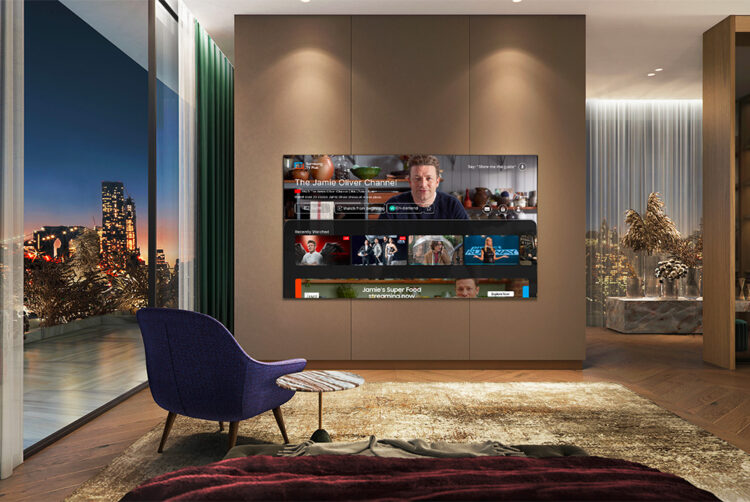Examining the shifting streaming habits of consumers - and what this means for marketers

Partner content
Samsung Ads’ report highlights a clear shift taking place across the streaming world and outlines why smart TVs are a valuable tool for brand marketers.
Convenience is king for consumers. They want to seamlessly access their favourite content without disrupting already-hectic routines — and streaming services are adept at catering to this expectation.
‘Binge watching’ has become a staple of modern life. Vast digital libraries full of premium curated content have allowed video-on-demand (VOD) channels to thrive. The VOD offerings can be broken down into three distinct categories — although these definitions are ever-evolving together with the TV landscape:
- Advertising video-on-demand (AVOD) — YouTube, Samsung TV Plus and Rakuten are examples; the latter two can be differentiated as free ad-supported TV (FAST), channels available via on-demand and scheduled
- Broadcaster video-on-demand (BVOD) — examples include ITV Hub and BBC iPlayer
- Subscription video-on-demand (SVOD) — high-profile examples include Netflix, Amazon Prime and Disney+
Subscription-funded models have dominated the streaming landscape for more than a decade — but their position is being challenged by the emergence of alternatives, such as ad-funded models. Some SVOD companies are feeling the pressure — Netflix reported a loss of subscribers for two consecutive quarters earlier this year.
Using a strong combination of proprietary and third-party data, Samsung Ads has compiled a report examining current consumer streaming habits. Decoding the Streaming Landscape observes over-the-top (OTT) app usage across EU5 markets — these include:
- Germany
- France
- Italy
- Spain
- UK
The report highlights a clear shift taking place across the streaming world and outlines why Smart TVs are a valuable tool for brand marketers. Forecasts predict 85% of Western European households will own a Smart TV by 2026. Continued consumer diversification, however, means advertisers must look further afield to gain traction with audiences.
Streaming’s rise to prominence
Streaming first overtook linear in terms of total TV viewing time during the pandemic — and it hasn’t relinquished its lead since. Streaming accounted for 52% of Samsung TV owners’ total TV time in H1 2022 which amounts to almost two hours per day. This compares to 48% of time dedicated to linear environments.
But this doesn’t mean there aren’t discrepancies across different streaming channels. The landscape is becoming increasingly fragmented — AVOD’s share of total viewing time increased by five percentage points between January-June 2022, whilst SVOD witnessed a five percentage point decline during the same period.
SVOD’s current ‘subscription churn’ challenge has multiple causes. Netflix and Amazon Prime — titans of the streaming world — announced earlier this year that they would be raising their base subscription costs. This was followed by a cost-of-living crisis that has prompted consumers to prioritise their expenses. More and more SVOD platforms have also signalled their intent to incorporate advertising into their services and become a cross between SVOD and AVOD.
Ads have been a staple part of the television viewing experience for years yet haven’t always been universally welcomed by consumers. But attitudes appear to be changing. Research shows that 69% of UK consumers are now amenable to ads within free-to-watch content provided they are relevant.
FAST has been a primary beneficiary of this shift in consumers’ expectations. And whilst these channels are relatively new — and don’t possess the reach of the aforementioned streaming giants — they have made a sizeable impact. The number of monthly FAST users increased by 9% between H1 2021-22, with average monthly hours consumed rising by 19% in the same period.
A combined offering of scheduled ‘live’ channels and on-demand content is a key factor in FAST’s popularity. Ease-of-access should also be mentioned, with certain apps and services pre-installed on newly purchased Smart TVs.
But how does Samsung’s own FAST option fit into the equation?
The final piece of the streaming puzzle
Samsung TV Plus, when launched in 2015, became one of the first FAST channels to be developed by a Smart TV manufacturer. This streaming service comes pre-programmed on new Samsung Smart TVs.
Delivering a seamless, convenient experience is a major driving force in Samsung TV Plus’ sustained success — but it isn’t the only notable factor. Users cited three primary reasons behind recommending the service to others:
- Valuable content
- Diverse content catalogue featuring news, sport, entertainment and older shows which foster a sense of nostalgia
- Unique service
- Samsung TV Plus comes pre-programmed on Smart TVs, without the need for additional downloads or subscriptions
- Love for the Samsung brand
- The established brand name – and the existing affinity it possesses – gives SamsungTV Plus a head-start on challenger options emerging onto the market
Samsung TV Plus has carved out a niche as the preeminent FAST streaming service. The platform scored 8% higher than the next highest-scoring FAST platform in EU5.
Streaming audiences are typically labelled as ‘hard to reach’ using traditional linear channels — 48% of Samsung TV audiences fit into this category. Break this down further and 26% of users exclusively watch OTT and 22% are ‘light linear’ viewers. Brand marketers must broaden their horizons and explore different avenues to connect with audiences – and this is where Samsung TV Plus shines.
CTV – the future of television advertising?
Linear remains integral to brand marketers’ strategies. It has been a reliable channel for decades — but as the TV viewership continues to fragment, advertisers need to broaden their horizons to find their missing audiences. Streaming environments, and particularly FAST platforms, are only going to become more popular. This is the opportune moment to capitalise on this shift.
Consumers expect convenience, curated content and relevance. Implementing Samsung TV Plus into the advertising mix is the catalyst to delivering all three — this is the stepping stone to breaking new ground with new audiences.
Download ‘Decoding the Streaming Landscape’ today to access all of the insights and follow Samsung Ads Europe on LinkedIn for regular insights.



